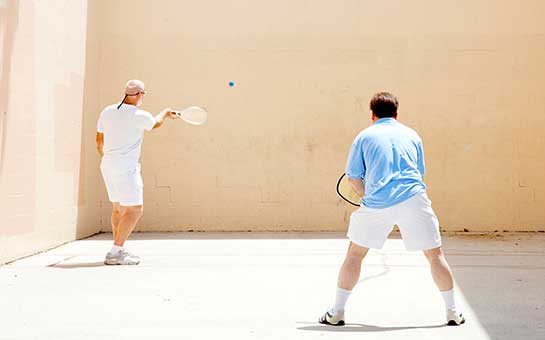Racquetball is a very popular indoor sport. It is often confused with a similar game, squash. Racquetball uses a racket that is wider and shorter than the one used in squash. Also, the racquetball court is slightly bigger than the squash court. The indoor sport is played inside a four-walled court with transparent walls for spectators. It’s an excellent sport for cardiovascular health and quick mobility.
While travelling away from your home country, you may find yourself indulging in this sport. It’s a great alternative to running and jogging. However, it is highly advised to buy racquetball hazardous sports travel insurance if you think you might be playing the game on your trip. It can mitigate the financial risks of medical treatments in case of an injury.
Travel Insurance for Racquetball
When buying racquetball hazardous travel insurance, keep these things in mind:
- Most standard travel insurance plans don’t include coverage for potentially hazardous activities like racquetball, so make sure you read the fine print before purchase to find a plan that does.
- Experts recommend buying travel health insurance for racquetball with cashless hospitalization benefits.
- If you have a recurring injury that is also common with racquetball, make sure your racquetball insurance plan provides coverage for it.
Basics of Racquetball
The sport is usually played in a four-walled court 40 feet in length and 20 feet in width (about 12 meters’ length by 6 meters’ width). Each wall is 20 feet (6 meters) high and is made from transparent fiberglass for spectating. The sport promises an intense cardiovascular session when played properly. The game can be enjoyed in singles or doubles with friends, family, and colleagues.
You just require a racquet and a racquetball to play the game. The racquet used in the game is shorter than a squash racket, but the teardrop-shaped string area is wider than that of the squash racket. The rubber ball used to play racquetball is hollow or slightly punctured. The bouncy and punctured ball is harder to hit and control, making the sport intense.
Racquetball is a fairly simple sport to enjoy. There are not many rules that you’re bound to follow, making it an amazing and enjoyable indoor sport. After the service is completed, players are required to hit the ball to the walls with their racquets alternatively, although you cannot obstruct your opponent while hitting the ball. The player earns a point when their opponent misses the shot.
To indulge in this fast-paced and intense sport is more than just a physical activity. Players are required to use their mental and physical strengths to play this sport. The quick movements and nimble footwork put the body under a lot of stress. The ligaments, tendons, and muscles are always exposed to injuries due to the physical needs of racquetball.
Risks of Playing Racquetball
Racquetball is an intense sport requiring speed, technique, and strength. There is always the possibility of muscle and bone injuries due to such strenuous movement. However, the rubber ball can pose a threat, too. Treatment of these injuries abroad may cost you a hefty sum. Buy adventure sports travel insurance for racquetball and be ready for any such financial risks.
- Improper landings or falling down can cause mild to severe sprains and fractures. Ankles and wrists are most prone to these types of injuries.
- Facial injuries can occur from impact by the ball or the racquet itself. Cuts and bruises to the face are common injuries that players can incur.
- Although uncommon, injuries of the elbow like tennis elbow, bursitis, and tendonitis can occur.
- Shoulder injuries and dislocations can occur due to the swinging of the racquet.
